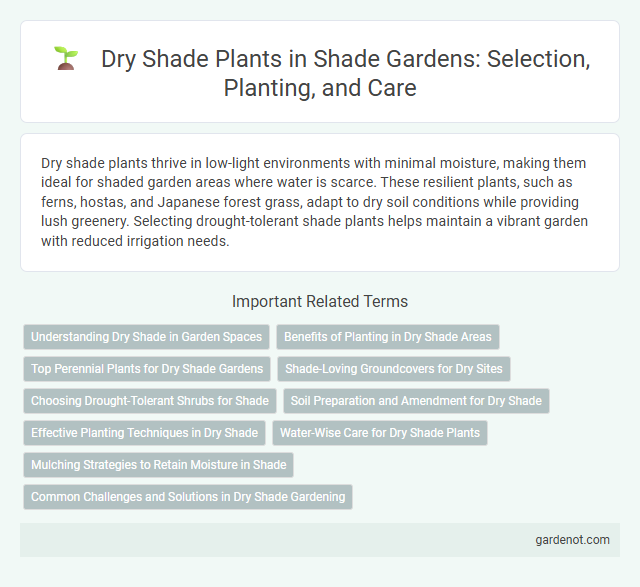Dry shade plants thrive in low-light environments with minimal moisture, making them ideal for shaded garden areas where water is scarce. These resilient plants, such as ferns, hostas, and Japanese forest grass, adapt to dry soil conditions while providing lush greenery. Selecting drought-tolerant shade plants helps maintain a vibrant garden with reduced irrigation needs.
Understanding Dry Shade in Garden Spaces
Dry shade in garden spaces refers to areas that receive minimal direct sunlight and have dry soil conditions, often under dense tree canopies or on the north side of buildings. Plants adapted to dry shade environments, such as hostas, ferns, and hellebores, are essential for thriving in these challenging conditions because they tolerate low moisture and limited light. Selecting the right dry shade plants enhances garden aesthetics while ensuring low maintenance and sustainability in shaded, dry microclimates.
Benefits of Planting in Dry Shade Areas
Dry shade plants thrive in low-moisture, low-light environments, improving soil quality and reducing erosion in shaded garden spots. These plants require minimal watering and maintenance, conserving water and lowering garden upkeep costs. Their unique adaptations support biodiversity by providing habitat and food sources for shade-tolerant wildlife and pollinators.
Top Perennial Plants for Dry Shade Gardens
Hostas are top perennial plants for dry shade gardens due to their drought tolerance and lush foliage. Ferns, such as the lady fern and Japanese painted fern, thrive well in dry shade areas by maintaining moisture efficiently. Other excellent choices include bleeding hearts and Heuchera, which provide vibrant blooms and foliage while requiring minimal water in shaded, dry conditions.
Shade-Loving Groundcovers for Dry Sites
Shade-loving groundcovers for dry sites, such as Pachysandra terminalis, Vinca minor, and Lamium maculatum, thrive in low-light, well-drained conditions, providing lush foliage and erosion control. These drought-tolerant plants require minimal maintenance while enhancing garden aesthetics with dense, spreading growth in shaded, dry areas. Selecting species with deep root systems improves soil stability and moisture retention in challenging dry shade environments.
Choosing Drought-Tolerant Shrubs for Shade
Choosing drought-tolerant shrubs for dry shade areas ensures survival and low maintenance in challenging garden spots. Species like evergreen boxwood, mahonia, and inkberry holly thrive with limited water while providing year-round structure and visual interest. These shrubs enhance shade gardens by combining resilience with aesthetic appeal, making them ideal for dry, shaded environments.
Soil Preparation and Amendment for Dry Shade
Dry shade plants thrive in well-draining soil enriched with organic matter to retain moisture without waterlogging. Incorporate compost, leaf mold, or well-rotted manure to improve soil structure and nutrient content, promoting healthy root growth in shaded, dry conditions. Adjust soil pH to slightly acidic or neutral depending on the specific plant species to optimize nutrient availability and plant vigor.
Effective Planting Techniques in Dry Shade
Selecting drought-tolerant plants like ferns, hostas, and heucheras is essential for successful dry shade gardening. Incorporating well-draining organic mulch and improving soil with compost enhances moisture retention while preventing waterlogging. Strategic spacing and grouping plants according to their water needs optimize root access to limited moisture in dry shaded areas.
Water-Wise Care for Dry Shade Plants
Dry shade plants thrive with minimal water, making them ideal for low-moisture environments under trees or shaded areas. Key water-wise care techniques include deep, infrequent watering to encourage strong root growth and using mulch to retain soil moisture and regulate temperature. Selecting drought-tolerant species like ferns, hostas, and Heuchera ensures sustainability and reduces irrigation needs in shade gardens.
Mulching Strategies to Retain Moisture in Shade
Mulching with organic materials such as shredded leaves, pine needles, or bark chips helps retain moisture in dry shade gardens by reducing soil evaporation and regulating temperature. Applying a 2-3 inch layer around dry shade plants improves water retention and supports root health, particularly for moisture-sensitive species like hostas and ferns. Regular replenishment of mulch ensures consistent protection against drought stress while enhancing soil fertility and microbial activity.
Common Challenges and Solutions in Dry Shade Gardening
Dry shade gardening faces common challenges such as limited sunlight, low soil moisture, and competition from tree roots that hinder plant growth. Selecting drought-tolerant plants like ferns, hostas, and ajugas can improve survival rates by thriving in low light and dry conditions. To enhance soil retention and moisture, mulching with organic materials and amending soil with compost are effective solutions for dry shade gardens.
Dry shade plant Infographic

 gardenot.com
gardenot.com